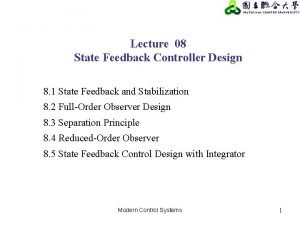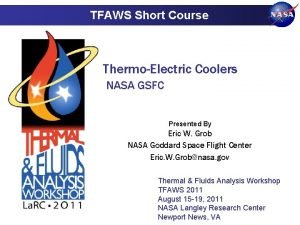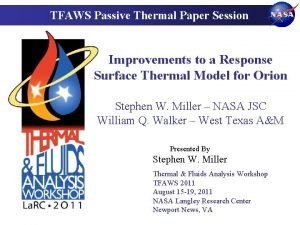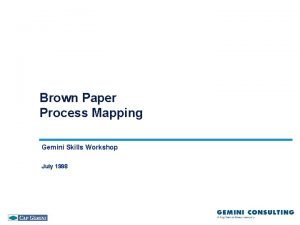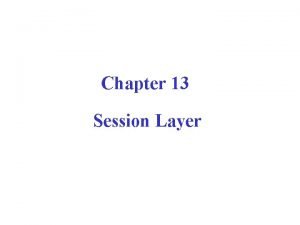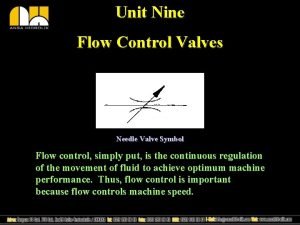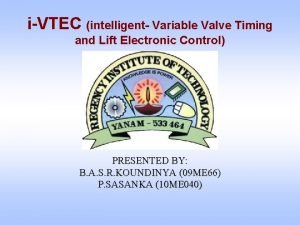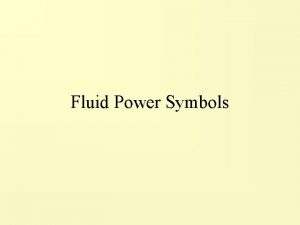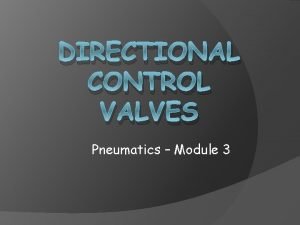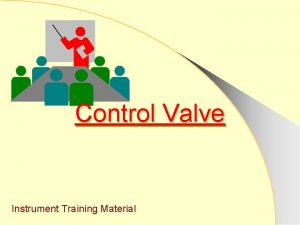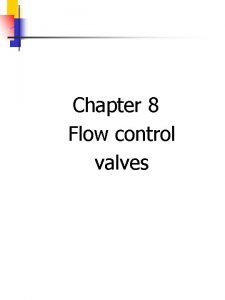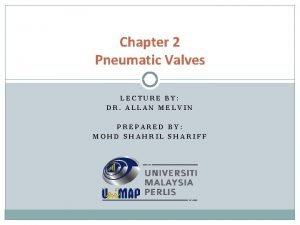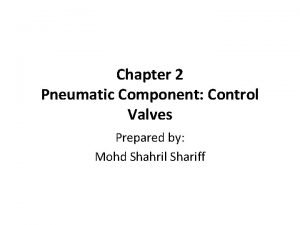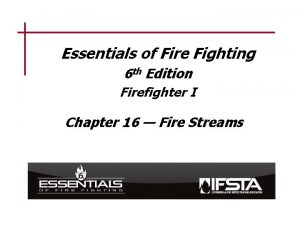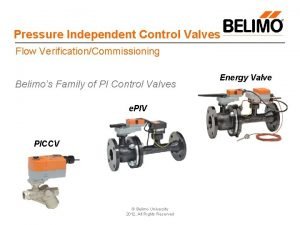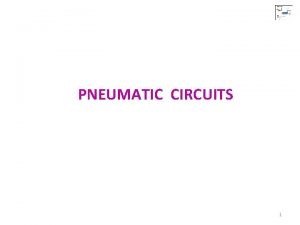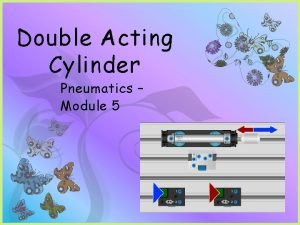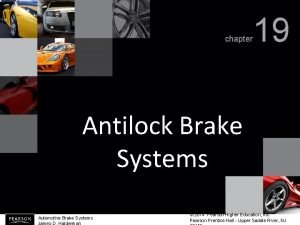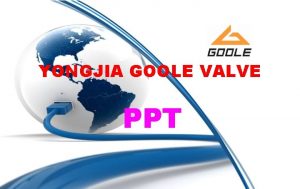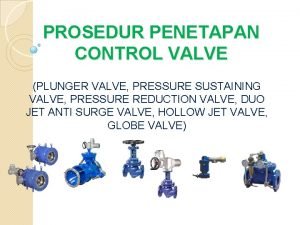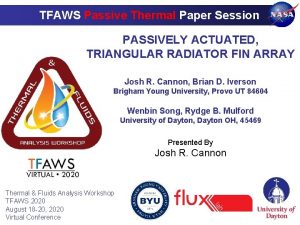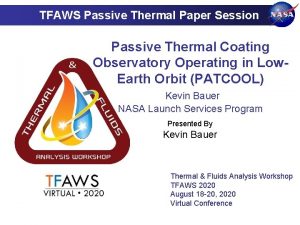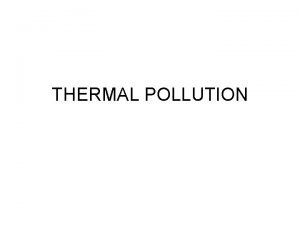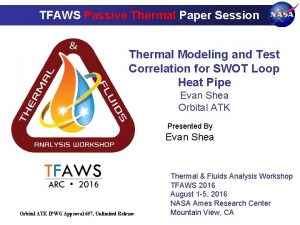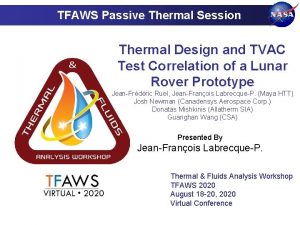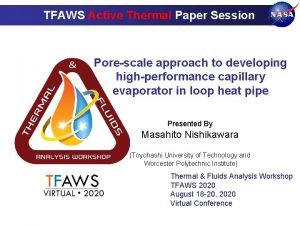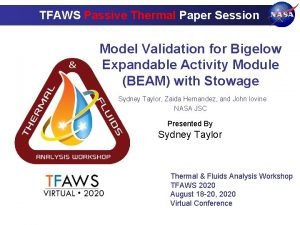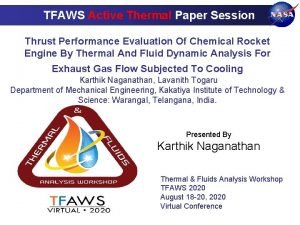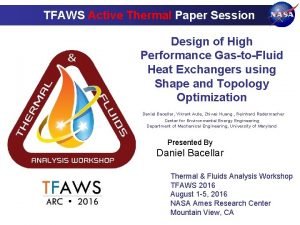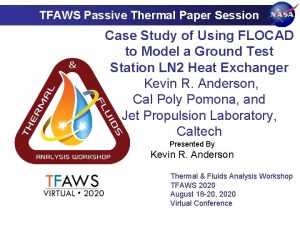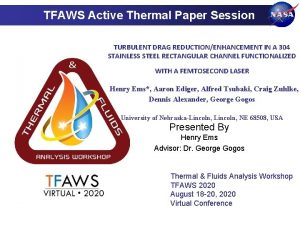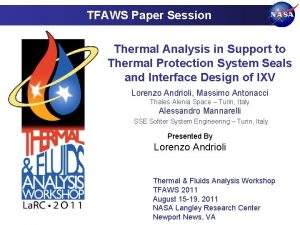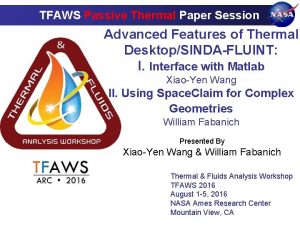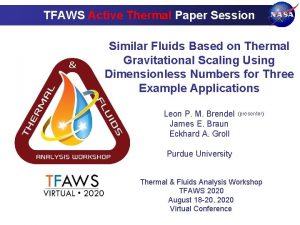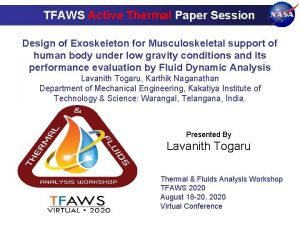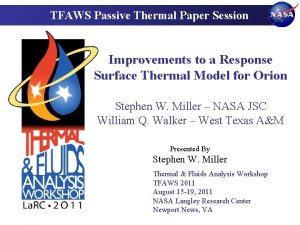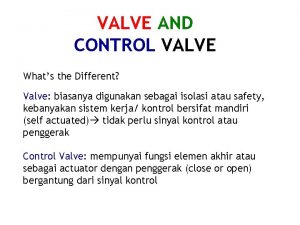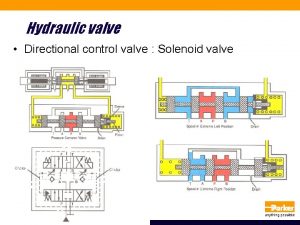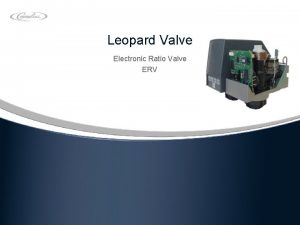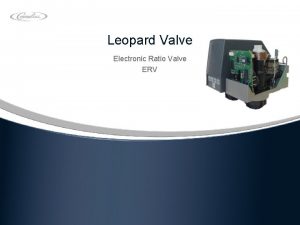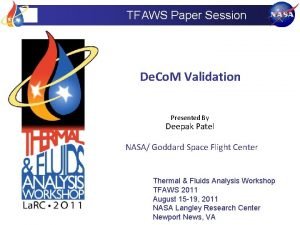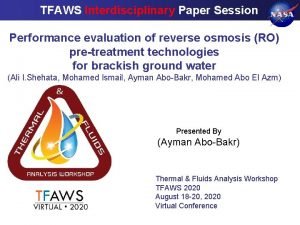TFAWS Paper Session LHP with Thermal Control Valve





























- Slides: 29

TFAWS Paper Session LHP with Thermal Control Valve for Variable Thermal Conductance Link of Lunar Landers and Rovers J. R. Hartenstine, W. G. Anderson & K. L. Walker Advanced Cooling Technologies, Inc. Bill. Anderson@1 -act. com Presented By Calin Tarau Thermal & Fluids Analysis Workshop TFAWS 2011 August 15 -19, 2011 NASA Langley Research Center Newport News, VA

Presentation Agenda ® ® Motivation Design Targets Variable Thermal Link Loop Heat Pipe Operation, Thermal Control Valve Integration, Operational Scenarios ® LHP with Thermal Control Valve – Design – Manufacturing – Testing ® Conclusions ® Acknowledgements ADVANCED COOLING TECHNOLOGIES, INC. ISO 9001 -2008 & AS 9100 -B Certified 2

Motivation ® Future lunar surface missions, such as the International Lunar Network (ILN) Anchor Node will require a variable thermal link for thermal management of the Warm Electronics Box (WEB) and batteries ® The lunar environment presents a number of challenges to the design and operation of radiator panels – During the day, the heat rejection sink can be 330 K – At night or in dark craters it can drop down to 50 K. Need to conserve heat to keep the electronics and battery warm during the lunar night – Instruments and equipment, such as batteries, will need to be maintained within -20ºC to 40ºC throughout the large diurnal temperature swings. ADVANCED COOLING TECHNOLOGIES, INC. ISO 9001 -2008 & AS 9100 -B Certified 3

Design Targets Minimum Electronics Temperature Maximum Electronics Temperature Power During Lunar Day/Night – Stirling Power During Lunar Day/Night – Solar Power During Transit Trip Length Duration Warm Electronics Box Geometry Will be Larger for Solar Option Radiator Dimensions Maximum Tilt -10°C (263 K) 30°C (303 K) 52 W/52 W 60 W/20 W Assume Full Power 5 Days, or Several Months ~ 6 years 21. 5” x 13” x 15” height 21” (tall) x 25” (wide) 20° (10° slope, 10° hole) Solar power controls, Maximum Day and Minimum Night ® Minimizing power usage at night is extremely important ® 1 W power = 5 kg Batteries and solar cells! (more for propulsion) ® 20° tilt means that conventional grooved aluminum/ammonia CCHPs can not be used in the WEB to isothermalize the system ADVANCED COOLING TECHNOLOGIES, INC. ISO 9001 -2008 & AS 9100 -B Certified 4

Variable Thermal Link ® Three basic elements to the WEB thermal control system 1. 2. 3. A method to isothermalize the electronics and battery during the lunar night, and to remove heat to a second, variable conductance thermal link during the day. A variable thermal link between the WEB and the Radiator A radiator to reject heat ® Possible Thermal Links – – Pumped loop Thermal Switch Variable Conductance Heat Pipes (VCHPs) Loop Heat Pipes (LHPs) ADVANCED COOLING TECHNOLOGIES, INC. ISO 9001 -2008 & AS 9100 -B Certified 5

Comparison of Thermal Links ® Partially based on Mars Rover Thermal Links from Birur, Pauken, and Novak (2002) Technology Attributes Practical Heat Transfer Capacity Range, W Active/Passive System Configuration Flexibility Mechanical Heat Switch VCHP Mini Loop Heat Pipe Mechanically Pumped Coolant Loop 1 to 20 1 to over 100 10 to over 100 25 to over 500 Passive Not flexible, needs to be located close to the heat sink Flexible Passive Very flexible, can easily transfer heat over large distances, over a meter Constrained to small foot print No constraint on foot print 0. 3 to 0. 5 10 to 15 0. 01 to 0. 03 1 for "off condition" 5 for start up (a few min. ) Active Very Flexible, can transfer heat over an order of magnitude longer distance No constraint on foot print 4 to 20 5 to 10 0. 03 to 0. 05 3 to 10 for "on condition" (including electronics) Excellent for Space Heat Collection Flexibility Constrained to small (at source) foot print Heat Rejection Flexibility Constrained to small (at sink) foot print Typical mass, kg 0. 10 to 0. 12 Conductance, W/K On 0. 4 to 0. 5 Conductance, W/K Off 0. 02 to 0. 025 Constrained to small foot print 0. 3 to 0. 5 20 0. 01 to 0. 04 Electric Power, W None 1 -2 for tight thermal control Excellent (test on Mars) Excellent for grooved wicks Heritage ADVANCED COOLING TECHNOLOGIES, INC. ISO 9001 -2008 & AS 9100 -B Certified 6

Variable Thermal Links ® Pumped Loop – Reject – Moving Parts/Power ® Thermal Switch – Reject – Thermal switches were used on the batteries for the Mars Exploration Rovers Ú TRL Level 9 – Dropped from further consideration Ú Lower thermal conductance than VCHP or LHP solution Ú ~ 0. 5 W/K when on, versus > 10 for VCHPs and LHPs Ú Limited footprint for both heat input and heat rejection ® VCHPs, LHPs with Thermal Control Valve ADVANCED COOLING TECHNOLOGIES, INC. ISO 9001 -2008 & AS 9100 -B Certified 7

Variable Thermal Links ® LHP – LHPs have a TRL level of 9 – flown in space – Require power to shutdown – 1 W = 5 kg batteries ® VCHP with Hybrid Wick – – No power to shutdown Least expensive Requires wick development Discussed in a separate ICES paper ® LHP with Thermal Bypass Valve – Easier to interface to radiator than VCHP – No power to shutdown ADVANCED COOLING TECHNOLOGIES, INC. ISO 9001 -2008 & AS 9100 -B Certified 8

Loop Heat Pipe (LHP) Operation ® LHPs are high thermal conductance devices that are self-contained and passive ® Heat enters the evaporator and vaporizes the working fluid at the wick outer surface ® The vapor is collected by a system of grooves and headers ® The vapor flows down the vapor line to the condenser where it condenses as heat is removed by the cold plate – Most of the condenser is filled with a two-phase mixture ADVANCED COOLING TECHNOLOGIES, INC. ISO 9001 -2008 & AS 9100 -B Certified 9

Loop Heat Pipe (LHP) Operation ® Heart of the LHP is the evaporator and compensation chamber – These contain the primary and secondary wicks ® Compensation chamber (CC) is located adjacent to the evaporator and operates at a lower temperature – Creates a lower pressure of the saturated fluid in the CC – Lower pressure allows the condensate to flow from the condenser through the liquid return line to the CC – Fluid then flows into a central bayonet where it feeds the wick ADVANCED COOLING TECHNOLOGIES, INC. ISO 9001 -2008 & AS 9100 -B Certified 10

LHP Shut-Down ® Need to shut down LHP during the Lunar night – Minimize Heat Losses from the WEB ® Standard method uses a heater on the compensation chamber – During normal operation, the Compensation Chamber runs at a lower temperature than the LHP evaporator Ú Required to maintain lower pressure in CC – Activate heater to shut down – Increase saturation temperature and pressure of LHP – Cancels the pressure difference required to circulate the sub-cooled liquid from the condenser to the evaporator ® Standard method validated in spacecraft ® 1 W = 5 kg batteries ® Eliminate shutdown power with thermal control valve ADVANCED COOLING TECHNOLOGIES, INC. ISO 9001 -2008 & AS 9100 -B Certified 11

TCV Integration into LHP ® Thermal Control Valve (TCV) first proposed by Goncharov et al. for precise temperature control ® TCV in the current application passively shuts off the LHP as the LHP evaporator temperature drops ® The LHP evaporator and the TCV will be located within the WEB – Will be installed within the LHP vapor line at the exit of the evaporator – The vapor line will split within the TCV, routing vapor to either the radiator for heat rejection or to the liquid return line for radiator bypass ® There will be two different operational scenarios for the LHP with the TCV – Lunar day operation – Lunar night operation ADVANCED COOLING TECHNOLOGIES, INC. ISO 9001 -2008 & AS 9100 -B Certified 12

LHP with TCV Operational Scenarios Lunar Day Operation ® During Lunar day operation the LHP must remove the waste heat from the WEB and transport it to the radiator ® Vapor will exit the evaporator and enter the TCV ® Ratio of two outlet vapor streams from valve will change in response to inlet temperature and adjust valve spool accordingly resulting in more flow directed to the radiator as temperature increases ADVANCED COOLING TECHNOLOGIES, INC. ISO 9001 -2008 & AS 9100 -B Certified 13

LHP with TCV Operational Scenarios Lunar Night Operation ® During Lunar night operation the LHP must provide a thermal link as ineffective as possible – Prevent heat from leaving the WEB to ensure electronics and batteries are kept warm with minimal power – As sink decreases, ratio of the two outlet vapor streams from TCV will change in response to inlet temperature – TCV will adjust valve spooling resulting in more flow directed away from radiator and through bypass line ® Hot vapor will flow through the bypass line – Increase in temperature and associated saturation pressure will stop LHP circulation – Small portion of vapor could enter the radiator, but vapor will sub-cool or possibly freeze in the lines ADVANCED COOLING TECHNOLOGIES, INC. ISO 9001 -2008 & AS 9100 -B Certified 14

LHP with Thermal Control Valve Design ® TCV is located in the vapor line – The TCV splits the vapor line, routing vapor to the condenser for heat rejection, or the liquid return line for radiator bypass ® The LHP design was modified to provide two methods of supplying the CC with the liquid return PARAMETER Evaporator Length VALVE 6. 00 in (125. 92 cm) Evaporator OD 1. 00 in (2. 54 cm) Vapor Line OD 0. 25 in (0. 64 cm) Liquid Line OD 0. 125 in (0. 32 cm) Liquid Line Length Condenser OD 29. 72 in (75. 48 cm) – Directly back into the CC - feeding the vapor from the bypass line directly into the CC should minimize flow instabilities seen in previous LHP with TCV applications – Into the liquid return which then takes the fluid to the CC 0. 25 in (0. 64 cm) Condenser Length 97. 64 in (247. 99 cm) ADVANCED COOLING TECHNOLOGIES, INC. ISO 9001 -2008 & AS 9100 -B Certified 15

Thermal Control Valve Design and Manufacturing ® Thermal Control Valve was designed and manufactured by Pacific Design Technologies, Inc. for ACT – Currently used in the pumped thermal loop for the Mars Science Laboratory ® Wetted materials in the TCV are all stainless steel Valve/Vapor Inlet Temperature (ºC) ≤ 0ºC to +20ºC ≥ +20 ºC Outlet A to Condenser (%) Minimize Outlet B Bypass Condenser (%) Maximize Increase in Flow Decrease in Flow to Condenser to Bypass with Increasing Temperature Maximize Minimize ADVANCED COOLING TECHNOLOGIES, INC. ISO 9001 -2008 & AS 9100 -B Certified 16

Thermal Control Valve ® TCV pre-weld and post-weld performance was tested by PDT prior to delivery using gaseous nitrogen ® Results from pre-weld and post-weld performance testing are as expected – Temperature drops from 20ºC to 0°C, the ratio of flow switches so the flow transfers from outlet A to outlet B. – This continues until approximately 20°C where outlet A now has nearly 100% of the flow and outlet B has nearly 0% of the flow ADVANCED COOLING TECHNOLOGIES, INC. ISO 9001 -2008 & AS 9100 -B Certified 17

LHP with Thermal Control Valve Fabrication ADVANCED COOLING TECHNOLOGIES, INC. ISO 9001 -2008 & AS 9100 -B Certified 18

LHP with Thermal Control Valve Testing Test Plan ® Tests were performed to evaluate TCV operation to bypass flow while maintaining evaporator temperature based on the inlet vapor temperature ® Tests were also performed to demonstrate TCV operation by applying a constant power to the evaporator while the sink temp was decreased stepwise ® The overall LHP test plan was as follows: – Applied 115 W of power to the evaporator – Measured and recorded temperature profile across LHP until steady state reached – Decreased condenser temperature and kept the evaporator power constant – Measured and recorded temperature profile across LHP until steady state reached – Decreased power stepwise, while maintaining constant condenser temperature – Reduced power from 110 W to 25 W, 5 W and 0 W ADVANCED COOLING TECHNOLOGIES, INC. ISO 9001 -2008 & AS 9100 -B Certified 19

LHP with Thermal Control Valve Testing TC Locations ADVANCED COOLING TECHNOLOGIES, INC. ISO 9001 -2008 & AS 9100 -B Certified 20

LHP with Thermal Control Valve Testing Test Results - Overall Performance, -60 C Sink Condition ADVANCED COOLING TECHNOLOGIES, INC. ISO 9001 -2008 & AS 9100 -B Certified 21

LHP with Thermal Control Valve Testing Test Results – Refined within 4ºC to 20ºC temperature range ADVANCED COOLING TECHNOLOGIES, INC. ISO 9001 -2008 & AS 9100 -B Certified 22

LHP with Thermal Control Valve Testing Test Results, -60 C Sink Condition ® Initially, the ΔT between the evaporator and CC is 2 -3ºC, demonstrating flow through the loop while it operates at 19°C – Majority of the flow is through condenser – Temperature of vapor through bypass line is 18 -19ºC Ú Indicates little to no vapor flows through the bypass line ® When power is decreased, temperature of the vapor entering the TCV drops to 13ºC – Temperature of vapor in bypass lines increases temporarily to 19ºC and drops off to 5ºC – Indicates flow through bypass line, where vapor is being transferred to the CC inlet – ΔT between evaporator and CC decreases to <1ºC Ú Indicates a drop in flow through the loop and loop shut down – Temperature of liquid entering CC increases above condenser temperature Ú Indicates the fluid is being bypassed around the condenser ADVANCED COOLING TECHNOLOGIES, INC. ISO 9001 -2008 & AS 9100 -B Certified 23

LHP with Thermal Control Valve Testing Test Results – Overall, -10 C Sink Condition ADVANCED COOLING TECHNOLOGIES, INC. ISO 9001 -2008 & AS 9100 -B Certified 24

LHP with Thermal Control Valve Testing Test Results - Refined ADVANCED COOLING TECHNOLOGIES, INC. ISO 9001 -2008 & AS 9100 -B Certified 25

LHP with Thermal Control Valve Testing Test Results, -10 C Sink Condition ® Condenser temperature was set to -10°C ® Transient temperature changes occur around 90 minutes – Due to abrupt power reduction and amount of cold liquid returning to the CC ® ΔT between the CC midpoint and evaporator drops off sharply when power is reduced – Evaporator temperature is maintains at 15°C ® Temperature of vapor in the bypass line drops off as TCV temperature drops – Indicates flow in the bypass line ® At 200 minutes, the LHP has reached steady state – At 25 W of power the evaporator temp stays near 15°C – Power was reduced to 5 W and evaporator temp is unaffected ® Temperature oscillations were observed – Unsure if it is due to the same phenomena reported by other researchers – Liquid nitrogen to controller was on/off ADVANCED COOLING TECHNOLOGIES, INC. ISO 9001 -2008 & AS 9100 -B Certified 26

Conclusions ® A Loop Heat Pipe with a Thermal Control Valve was developed to provide a variable thermal link over a wide range of environmental thermal conditions for future lunar missions ® An integrated LHP and Thermal Control Valve system was designed, fabricated and tested to operate as a variable thermal link – Above the 20ºC maximum temperature set point, a majority of the vapor was routed to the condenser – Between 0ºC and 20ºC, a portion of the flow was bypassed to the compensation chamber – Below 0ºC, a majority of the flow is bypassed. ® At low sink conditions and power input, -60ºC and 0 -5 W, respectively, thermal performance testing shows that the LHP with a TCV can effectively reduce and shut down LHP flow and maintain the evaporator temperature without the need for electric power ADVANCED COOLING TECHNOLOGIES, INC. ISO 9001 -2008 & AS 9100 -B Certified 27

Acknowledgments ® This program was sponsored by NASA Marshall Space Flight Center under Purchase Order No. NNX 10 CF 21 P. Mr. Jeff Farmer, NASA/MSFC was the technical monitor for this Phase I program ® Tim Wagner and James Bean were the laboratory technicians responsible for the fabrication and testing of the demonstration heat pipe and nickel wick analysis, and Mr. Mike Ellis performed the Loop Heat Pipe model analysis. ® Any opinions, findings, and conclusions or recommendations expressed in this presentation are those of the authors and do not necessarily reflect the views of the National Aeronautics and Space Administration. ADVANCED COOLING TECHNOLOGIES, INC. ISO 9001 -2008 & AS 9100 -B Certified 28

TFAWS Paper Session LHP with Thermal Control Valve for Variable Thermal Conductance Link of Lunar Landers and Rovers J. R. Hartenstine, W. G. Anderson & K. L. Walker Advanced Cooling Technologies, Inc. Bill. Anderson@1 -act. com Presented By Calin Tarau Thermal & Fluids Analysis Workshop TFAWS 2011 August 15 -19, 2011 NASA Langley Research Center Newport News, VA
 Lhp
Lhp Nasa tfaws
Nasa tfaws Replexen
Replexen Mechanical servo valve
Mechanical servo valve Chapter 5 thermal energy answer key
Chapter 5 thermal energy answer key Thermal transfer vs direct thermal printing
Thermal transfer vs direct thermal printing Brown paper process
Brown paper process Session layer function
Session layer function Pneumatic flow control valve symbol
Pneumatic flow control valve symbol Lift electronic control
Lift electronic control Relief valve
Relief valve In a 3/2 way directional control valve, number 2 represents
In a 3/2 way directional control valve, number 2 represents Control valve flow characteristics
Control valve flow characteristics Throttle valve symbol
Throttle valve symbol Pneumatic time delay valve symbol
Pneumatic time delay valve symbol Pneumatic control valve function
Pneumatic control valve function Broken stream fire fighting
Broken stream fire fighting Picv valve symbol
Picv valve symbol Double acting cylinder diagram
Double acting cylinder diagram Difference between single acting and double acting
Difference between single acting and double acting Kelsey-hayes rwal modulator control valve
Kelsey-hayes rwal modulator control valve Goole valve
Goole valve Karakteristik control valve
Karakteristik control valve Control valve theory
Control valve theory Passive thermal control
Passive thermal control Passive thermal control
Passive thermal control Convrts
Convrts English general paper paper 2 comprehension
English general paper paper 2 comprehension Aice topics
Aice topics Primary control vs secondary control
Primary control vs secondary control
